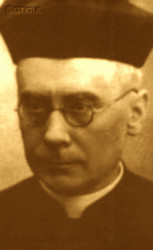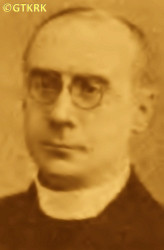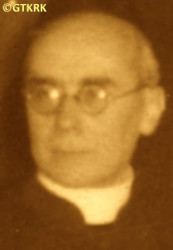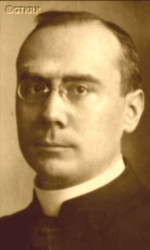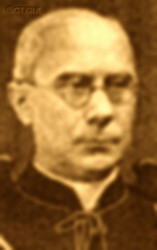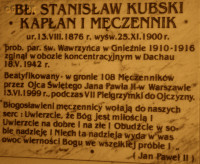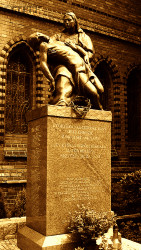Roman Catholic
St Sigismund parish
05-507 Słomczyn
85 Wiślana Str.
Konstancin deanery
Warsaw archdiocese, Poland
full list:
displayClick to display full list

searchClick to search full list by categories
wyświetlKliknij by wyświetlić pełną listę po polsku

szukajKliknij by przeszukać listę wg kategorii po polsku

Martyrology of the clergy — Poland
XX century (1914 – 1989)
personal data
religious status
blessed
surname
KUBSKI
forename(s)
Stanislav (pl. Stanisław)
beatification date
13.06.1999more on
www.swzygmunt.knc.pl
[access: 2013.05.19]

the RC Pope John Paul IImore on
en.wikipedia.org
[access: 2014.09.21]
function
diocesan priest
creed
Latin (Roman Catholic) Church RCmore on
en.wikipedia.org
[access: 2014.09.21]
diocese / province
Gniezno and Poznań archdiocese (aeque principaliter)more on
www.archpoznan.pl
[access: 2012.11.23]
RC Military Ordinariate of Polandmore on
en.wikipedia.org
[access: 2014.12.20]
honorary titles
Minor Canonmore on
en.wikipedia.org
[access: 2014.11.14]
(23.10.1935 – , St Peter and St Paul the Apostles and Nativity of the Blessed Virgin Mary RC collegiate church, Kruszwicatoday: Kruszwica gm., Inowrocław pov., Kuyavia‐Pomerania voiv., Poland
more on
en.wikipedia.org
[access: 2021.07.18])
Ad Honores Spiritual Counselor
(1923)
Minor Canonmore on
en.wikipedia.org
[access: 2014.11.14]
(till 1923, St George RC collegiate church, Gnieznotoday: Gniezno urban gm., Gniezno pov., Greater Poland voiv., Poland
more on
en.wikipedia.org
[access: 2021.12.18])
Gold „Cross of Merit”more on
en.wikipedia.org
[access: 2019.04.16]
(11.11.1937)
date and place
of death
18.05.1942

KL Dachau ‐ MunichGermany (Bavaria) ‐ Austria
alt. dates and places
of death
13.06.1942 (KL Dachau „death certificate” date)
TA HartheimSchloss Hartheim „euthanasia” center
today: Alkoven, Eferding dist., Salzburg state, Austria
more on
en.wikipedia.org
[access: 2022.07.18]
details of death
When in 1906‐1908 a strike of school children broke out in the Prussian part of partition Poland, i.e. in Germ. Province Posen (Eng. Province of Poznań) — children refrained from answering in German during religion lessons; began lessons with a morning prayer in Polish; greeted teachers with the traditional Polish „Praised be Jesus Christ”; parents certified in writing that they did not allow their children to answer in German during religion lessons — which broke out in c. 800 schools (25‐60% of all schools in each district) and c. 75,000 students, spoke at protest rallies, including in Śrem on 27.08.1906 and in 10.1906. The latter convened and led it, but it seems the police dissolved it. In 1906‐1909 member of the Polish Electoral Committee in the Germ. Kreis Schrimm (Eng. Środa County), in the Germ. Provinz Posen — in 1906 as a representative of the Bnin district, in 1908 of the Śrem town district — supporting Polish candidates for the Germ. Preußischer Landtag (Eng. Prussian National Parliament)— elections took place in 1908 — and for the Germ. Reichstag (Eng. Reich Parliament) of the German Empire — elections took place in 1907. Spoke, among others, at a rally in Śrem on 01.1919, probably during by‐elections.
In 1911, after organizing an educational lecture, fined by the German authorities in Gniezno for „organizing political meetings without notifying the police”.
After the abdication on 09.11.1918 of the German Emperor William II Hohenzollern; after the signing on 11.11.1918 by the Allies and the Germans, in a staff wagon in Compiègne, at the headquarters of French Marshal Ferdinand Foch, of an armistice and ceasefire — which de facto meant the end of World War I; and also after the transfer on 11.11.1918 by the Regency Council — operating in the so‐called Germ. Königreich Polen (Eng. Polish Kingdom), i.e. the territory occupied by the Central Powers (Germany and Austria–Hungary) — of supreme military authority to Brigadier Joseph Piłsudski and appointing him Commander‐in‐Chief of the Polish Army, which de facto meant the rebirth of the Polish state, however, covering only the Germ. Königreich Polen, i.e. the Polish territory under Russian rule until 1915, and excluding the lands of the Prussian partition; I; a period of chaos ensued in Germany, also encompassing Polish lands, including Greater Poland — i.e. the Prussian Germ. Provinz Posen — which was still formally part of the German state. In Gniezno, where ministered, a revolutionary Soldiers' Council was established on 10.11.1918, based mainly on German soldiers stationed in the Gniezno barracks. In response, on 12.11.1918, a Workers' Council was established with a Polish majority. Both clashed over the scope of competences in managing the city. But in mid 11.1918, a third structure was also established, the Polish Provisional People's Council, which was the Gniezno representative of the Polish Supreme People's Council, founded on 11.11.1918 in Poznań. Became its member. And on 17.11.1918, it was transformed into the City People's Council, of which also became a member (three days later, the District People's Council was also established) — and a member of the school committee and the political committee of this Council. Council was recognized as Polish legal state authority by the so‐called Polish District Parliament, whose delegates came from the lands of the former Prussian partition and which met on 03‐05.12.1918 in the „Apollo” cinema in Poznań (this Parliament also expressed its will to incorporate the lands from which the delegates came into a united Polish state with access to the sea).
The Gordian knot that had been created was untied on 27.12.1918, when the Greater Poland Uprising of 1918‐1919 broke out. The insurgents whom he served as their chaplain had taken over Gniezno already on 28.12.1918, but the decisive battle for the district was the Battle of Zdziechowa, c. 8 km from Gniezno, fought on 30‐31.12.1918, when the Poles stopped the German counter–offensive and defeated the Prussian Grenzschutz units. Immediately afterwards, sat on the Electoral Commission, which led to the establishment of a new City Council in 03.1919 and its assumption of full power in the city — was a member of it. During the Polish–Russian War of 1919‐1921, became a part–time auxiliary chaplain of the Polish Army — volunteered and on 04.09.1919 took over the pastoral care of soldiers who, for various reasons, remained in the Gniezno barracks while the rest had set off to the battlefront: had 2,772 soldiers under his care, 586 of whom were in hospitals.
In 08.1939, due to the threat of German aggression, became a member of the Citizens' Committee of National Emergency established in Inowrocław.
After the German invasion of Poland on 01.09.1939 (Russians attacked Poland 17 days later) and the beginning of World War II, on 04.09.1939 — due to the approach of German troops and the evacuation of the city authorities to the south of Poland — delivered a patriotic speech to the residents of Inowrocław gathered in the Market Square.
Arrested by the Germans on 08.09.1939, the day after the German occupation of the town began.
Jailed in army barracks in Inowrocław.
Next on 09‐10.09.1939 held in ZL Albatros transit camp in Piła.
From there on 21‐23.09.1939 transported to KL Dachau concentration camp and three days later, on 26.09.1939 moved to KL Buchenwald concentration camp where slaved in quarries.
Next on 24.10.1940 moved back to KL Dachau concentration camp.
Finally — totally exhausted — transported out in a so‐called Germ. „Invalidentransport” (Eng. „Invalids' transport”) to TA Hartheim Euthanasia Center where the victims were being taken and murdered in a gas chamber.
Did not reach the destination — prob. already in the camp, just before the formation of the Germ. „Invalidentransport” and loading of the victims on the railway siding in KL Dachau onto the freight wagon in which the prisoners were transported, or on the first stage of the journey to the Euthanasia Center TA Hartheim, on the way to Munich, and there thrown out of the wagon and then incinerated in the city crematorium.
According to the death certificate, prepared in KL Dachau, the „honest” otherwise German „medical doctors” and formalists — and at the same time, unrivaled fairy tale spinners — noted that the cause of death was Germ. „Versagen des Kreislaufes bei Herzmuskelentartung” (Eng. „Failure of the circulatory system with diabetic dysentery”).
prisoner camp's numbers
4779Click to display source page (KL BuchenwaldClick to display the description), 35773, 20678Click to display source page (KL DachauClick to display the description)
cause of death
extermination: exhaustion and starvation
perpetrators
Germans
sites and events
TA HartheimClick to display the description, «Aktion T4»Click to display the description, KL BuchenwaldClick to display the description, KL DachauClick to display the description, ZL AlbatrosClick to display the description, «Intelligenzaktion»Click to display the description, Ribbentrop‐MolotovClick to display the description, Pius XI's encyclicalsClick to display the description, Greater Poland UprisingClick to display the description
date and place
of birth
13.08.1876Birth certification on:
www.genealogiawarchiwach.pl
[access: 2025.09.08]

Książtoday: Strzelno gm., Mogilno pov., Kuyavia‐Pomerania voiv., Poland
more on
en.wikipedia.org
[access: 2021.07.15]
parents
KUBSKI Michael
🞲 1853, ? — 🕆 1949, ?

GŁUSZEK Francesca
🞲 1854, ? — 🕆 ?, ?
baptism
20.08.1876Birth certification on:
www.genealogiawarchiwach.pl
[access: 2025.09.08]

Polanowicetoday: Kruszwica gm., Inowrocław pov., Kuyavia‐Pomerania voiv., Poland
more on
pl.wikipedia.org
[access: 2022.02.03]
St Clement the Pope RC church
presbyter (holy orders)
ordination
25.11.1900

Gnieznotoday: Gniezno urban gm., Gniezno pov., Greater Poland voiv., Poland
more on
en.wikipedia.org
[access: 2021.12.18]
positions held
1925 – 1939
dean — Inowrocławtoday: Inowrocław gm., Inowrocław pov., Kuyavia‐Pomerania voiv., Poland
more on
en.wikipedia.org
[access: 2021.07.18] RC deanery
1923 – 1939
parish priest — Inowrocławtoday: Inowrocław gm., Inowrocław pov., Kuyavia‐Pomerania voiv., Poland
more on
en.wikipedia.org
[access: 2021.07.18] ⋄ Annunciation to the Blessed Virgin Mary RC parish ⋄ Inowrocławtoday: Inowrocław gm., Inowrocław pov., Kuyavia‐Pomerania voiv., Poland
more on
en.wikipedia.org
[access: 2021.07.18] RC deanery — also: inspector of religious education in primary schools in the Inowrocław county/deanery (c. 1931‐1939), deputy to the Archbishop's Theological Seminary estate board (c. 1929‐1939), Archbishop's delegate at the final exams at the Pedagogical High School / Teachers' Seminar in Inowrocław (c. 1929‐1939), member of the Association of Missionary Priests „Good Shepherd” (c. 1929‐1934), director of the Gniezno diocesan Association of Priests–Adorers (c. 1923‐1939)
23.10.1935 – 1939
Minor Canon — Kruszwicatoday: Kruszwica gm., Inowrocław pov., Kuyavia‐Pomerania voiv., Poland
more on
en.wikipedia.org
[access: 2021.07.18] ⋄ Collegiate Chapter ⋄ St Peter and St Paul the Apostles RC collegiate church
1923 – 1939
administrator — Inowrocławtoday: Inowrocław gm., Inowrocław pov., Kuyavia‐Pomerania voiv., Poland
more on
en.wikipedia.org
[access: 2021.07.18] ⋄ Name of the Blessed Virgin Mary RC parish ⋄ Inowrocławtoday: Inowrocław gm., Inowrocław pov., Kuyavia‐Pomerania voiv., Poland
more on
en.wikipedia.org
[access: 2021.07.18] RC deanery
1923 – 1926
chaplain — Inowrocławtoday: Inowrocław gm., Inowrocław pov., Kuyavia‐Pomerania voiv., Poland
more on
en.wikipedia.org
[access: 2021.07.18] ⋄ prison
till c. 1923
Minor Canon — Gnieznotoday: Gniezno urban gm., Gniezno pov., Greater Poland voiv., Poland
more on
en.wikipedia.org
[access: 2021.12.18] ⋄ Collegiate Chapter ⋄ St George the Martyr RC collegiate church
1921 – 1930
pro‐synodal judge — Gnieznotoday: Gniezno urban gm., Gniezno pov., Greater Poland voiv., Poland
more on
en.wikipedia.org
[access: 2021.12.18] ⋄ Archbishop's Metropolitan Court ⋄ Gniezno RC archdiocese
1921 – 1923
dean — Gniezno Holy Trinitydeanery name
today: Gniezno urban gm., Gniezno pov., Greater Poland voiv., Poland
more on
en.wikipedia.org
[access: 2021.12.18] RC deanery
1920 – 1923
membership — Gnieznotoday: Gniezno urban gm., Gniezno pov., Greater Poland voiv., Poland
more on
en.wikipedia.org
[access: 2021.12.18] ⋄ Management Board, Archbishop's Theological Seminary
1919 – 1922
RC auxiliary military chaplain — Gnieznotoday: Gniezno urban gm., Gniezno pov., Greater Poland voiv., Poland
more on
en.wikipedia.org
[access: 2021.12.18] ⋄ Polish Armed Forces
1916 – 1923
parish priest — Gnieznotoday: Gniezno urban gm., Gniezno pov., Greater Poland voiv., Poland
more on
en.wikipedia.org
[access: 2021.12.18] ⋄ Holy Trinity RC parish (main parish) ⋄ Gniezno Holy Trinitydeanery name
today: Gniezno urban gm., Gniezno pov., Greater Poland voiv., Poland
more on
en.wikipedia.org
[access: 2021.12.18] RC deanery — also: 1917‐1919 editor of the Pl. „Wiadomości Parafialne Gnieźnieńskie” (Eng. „Gniezno Parish News”) weekly; member of the Supervisory Board of the Printing House in Gniezno, which published, i.a., the daily — with a break in 12.1914‐1918, during World War I, when the Prussian authorities banned the publication of the newspaper — Pl. „Lech Gazeta Gnieźnieńska” (Eng. „Lech Gniezno Newspaper”)
director — Lat. „Apostolatus Orationis” (Eng. „Prayer Apostolate”) association ⋄ Gniezno RC archdiocese
1910 – 1916
parish priest — Gnieznotoday: Gniezno urban gm., Gniezno pov., Greater Poland voiv., Poland
more on
en.wikipedia.org
[access: 2021.12.18] ⋄ St Lawrence the Martyr RC parish ⋄ Gniezno Holy Trinitydeanery name
today: Gniezno urban gm., Gniezno pov., Greater Poland voiv., Poland
more on
en.wikipedia.org
[access: 2021.12.18] RC deanery
1912 – 1914
president — Gnieznotoday: Gniezno urban gm., Gniezno pov., Greater Poland voiv., Poland
more on
en.wikipedia.org
[access: 2021.12.18] ⋄ Agricultural and Peasant Collective
1910
administrator — Gnieznotoday: Gniezno urban gm., Gniezno pov., Greater Poland voiv., Poland
more on
en.wikipedia.org
[access: 2021.12.18] ⋄ St Lawrence the Martyr RC parish ⋄ Gniezno Holy Trinitydeanery name
today: Gniezno urban gm., Gniezno pov., Greater Poland voiv., Poland
more on
en.wikipedia.org
[access: 2021.12.18] RC deanery
1900 – 1910
vicar — Śremtoday: Śrem gm., Śrem pov., Greater Poland voiv., Poland
more on
en.wikipedia.org
[access: 2021.07.18] ⋄ Blessed Virgin Mary of the Assumption RC parish ⋄ Śremtoday: Śrem gm., Śrem pov., Greater Poland voiv., Poland
more on
en.wikipedia.org
[access: 2021.07.18] RC deanery — also: 1904 director of the Parcelization Bank in Śrem; vice‐president of the Supervisory Board of the People's Bank in Śrem
till 1900
student — Gnieznotoday: Gniezno urban gm., Gniezno pov., Greater Poland voiv., Poland
more on
en.wikipedia.org
[access: 2021.12.18] ⋄ philosophy and theology, Archbishop's Practical Theological Seminary (Lat. Seminarium Clericorum Practicum)
from 1897
student — Poznańtoday: Poznań city pov., Greater Poland voiv., Poland
more on
en.wikipedia.org
[access: 2021.07.18] ⋄ philosophy and theology, Archbishop's Theological Seminary (Collegium Leoninum)
comments
The urn with ashes — cremation prob. took place in the crematorium at the Germ. Ostfriedhof (Eng. Eastern Cemetery) in Munich — since 1950 has been kept at the Am Perlacher Forst cemetery, in a place known as Germ. Ehrenhain I (Eng. „Remembrance Grove No. 1”), in Munich. In 2013, information about the „disclosure” of the cremated remains of the KL Dachau victims made it to the front pages of news outlets. His urn bears the No. K3940.
others related
in death
CIEMNIAKClick to display biography Louis, DEMSKIClick to display biography Vladislav, FARULEWSKIClick to display biography Thaddeus, GOTOWICZClick to display biography Louis, KOMPFClick to display biography January Sigismund, KUBICKIClick to display biography Telesphorus, LUDWICZAKClick to display biography Anthony John, ŁÓJClick to display biography John, MATUSZEWSKIClick to display biography Francis Adam, MĄKOWSKIClick to display biography John, MULLERClick to display biography Joseph Stanislav Kostka, NIEMIRClick to display biography Joseph, POMIANOWSKIClick to display biography Vladislav, SCHOENBORNClick to display biography Steven Charles Francis, SKOWRONClick to display biography Casimir, STREHLClick to display biography Mieczyslav, SZUKALSKIClick to display biography John Wladysław, WĄSOWICZClick to display biography Sigismund, WŁODARCZYKClick to display biography Ignatius
sites and events
descriptions
TA Hartheim: From 05.1940, in the Germ. Tötungsanstalt (Eng. Killing/Euthanasia Center) TA Hartheim, at the Schloss Hartheim castle in Alkoven in Upper Austria, belonging to KL Mauthausen‐Gusen complex of concentration camps, as part of «Aktion T4» program, the Germans murdered victims — people mentally retarded and disabled — in gas chambers with carbon monoxide. Till 24.08.1941 and the formal end of the «Aktion T4» program, c. 18,000 people were murdered in TA Hartheim. In 04.1941 the program was extended to include concentration camp prisoners. Most, if not all, of the murdered clergy from the KL Dachau concentration camp were taken to TA Hartheim in the so‐called Germ. „Invalidentransport” (Eng. „transport of invalids”), prisoners who were sick and, according to the Germans, „unable to work” (initially under the pretext of transfer to a better camp) — after the formal end of «Aktion T4» as part of the program codenamed «Aktion 14 f 13». It is estimated that at this stage — until 11.12.1944 — c. 12,000 prisoners were gassed at TA Hartheim.
Note: The dates of death of victims murdered in Schloss Hartheim indicated in the „White Book” are the dates of deportations from the last concentration camp the victims where held in. The real dates of death are unknown — apart from c. 49 priests whose names were included in the niem. „Invalidentransports”, but who did not arrive at TA Hartheim. Prob. perished on the day of transport, somewhere between KL Dachau and Munich, and their bodies were thrown out of the transport and cremated in Munich. The investigation conducted by Polish Institute of National Remembrance IPN concluded, that the other victims were murdered immediately upon arrival in Schloss Hartheim, bodies cremated and the ashes spread over local fields and into Danube river. In order to hide details of the genocide Germans falsified both dates of death (for instance those entered into KL Dachau concentration camp books, which are presented in „White Book” as alternative dates of death) and their causes. (more on: ipn.gov.plClick to attempt to display webpage
[access: 2019.05.30], en.wikipedia.orgClick to attempt to display webpage
[access: 2019.05.30])
«Aktion T4»: German state euthanasia program, systematic murder of people mentally retarded, chronically, mentally and neurologically ill — „elimination of live not worth living” (Germ. „Vernichtung von lebensunwertem Leben”). At a peak, in 1940‐1941, c. 70,000 people were murdered, including patients of psychiatric hospitals in German occupied Poland — German formalists noted then that, among others, „performing disinfection [i.e. gassing] of 70,273 people with a life expectancy of up to 10 years saved food in the amount of 141,775,573.80 Deutschmark”. From 04.1941 also mentally ill and „disabled” (i.e. unable to work) prisoners held in German concentration camps were included in the program — denoted then as «Aktion 14 f 13». C. 20,000 inmates were then murdered, including Polish Catholic priests held in KL Dachau concentration camp, who were murdered in Hartheim gas chambers. The other „regional extension” of «Aktion T4» was «Aktion Brandt» program during which Germans murdered chronically ill patients in order to make space for wounded soldiers. It is estimated that at least 30,000 were murdered in this program. (more on: en.wikipedia.orgClick to attempt to display webpage
[access: 2014.10.31])
KL Buchenwald: In German Germ. Konzentrationslager (Eng. concentration camp) KL Buchenwald concentration camp, founded in 1937 and operational till 1945, Germans held c. 238,380 prisoners and murdered approx. 56,000 of them, among them thousands of Poles. Prisoners were victims of pseudo‐scientific experiments, conducted among others by Behring‐Werke from Marburg and Robert Koch Institute from Berlin companies. They slaved for Gustloff in Weimar and Fritz‐Sauckel companies manufacturing armaments. To support Erla‐Maschinenwerk GmbH in Leipzig, Junkers in Schönebeck (airplanes) and Rautal in Wernigerode Germans organized special sub‐camps. In 1945 there were more than 100 such sub‐camps. Dora concentration camp was initially one of them, as well as KL Ravensbrück sub‐camps (from 08.1944). On 08.04.1945 Polish prisoner, Mr Guido Damazyn, used clandestinely constructed short wave transmitter to sent, together with a Russian prisoner, a short message begging for help. It was received and he got a reply: „KZ Bu. Hold out. Rushing to your aid. Staff of Third Army” (American). Three days later the camp was liberated. (more on: www.buchenwald.deClick to attempt to display webpage
[access: 2013.08.10], en.wikipedia.orgClick to attempt to display webpage
[access: 2013.08.10])
KL Dachau: KL Dachau in German Bavaria, set up in 1933, became the main German Germ. Konzentrationslager (Eng. concentration camp) KL for Catholic priests and religious during World War II: On c. 09.11.1940, Reichsführer‐SS Heinrich Himmler, head of the SS, Gestapo and German police, as a result of the Vatican's intervention, decided to transfer all clergymen detained in various concentration camps to KL Dachau camp. The first major transports took place on 08.12.1940. In KL Dachau Germans held approx. 3,000 priests, including 1,800 Poles. The priests were forced to slave labor in the Germ. „Die Plantage” — the largest herb garden in Europe, managed by the genocidal SS, consisting of many greenhouses, laboratory buildings and arable land, where experiments with new natural medicines were conducted — for many hours, without breaks, without protective clothing, no food. They slaved in construction, e.g. of camp's crematorium. In the barracks ruled hunger, freezing cold in the winter and suffocating heat during the summer, especially acute in 1941‐1942. Prisoners suffered from bouts of illnesses, including tuberculosis. Many were victims of murderous „medical experiments” — in 11.1942 c. 20 were given phlegmon injections; in 07.1942 to 05.1944 c. 120 were used by for malaria experiments. More than 750 Polish clerics where murdered by the Germans, some brought to TA Hartheim euthanasia centre set up in Schloss Hartheim in Austria and murdered in gas chambers. At its peak KL Dachau concentration camps’ system had nearly 100 slave labour sub‐camps located throughout southern Germany and Austria. There were c. 32,000 documented deaths at the camp, and thousands perished without a trace. C. 10,000 of the 30,000 inmates were found sick at the time of liberation, on 29.04.1945, by the USA troops… (more on: www.kz-gedenkstaette-dachau.deClick to attempt to display webpage
[access: 2013.08.10], en.wikipedia.orgClick to attempt to display webpage
[access: 2016.05.30])
ZL Albatros: German transit Germ. Zivilgefangenenlager (Eng. camp for civilians) in Piła, operational in 09‐12.1939, mainly for Polish teachers and religious, who were treated especially rough, before transporting them to KL Sachsenhausen concentration camp, and for Jews. Prisoners were forced to slave in German manufacturing plants and local farms. Altogether more than 500 Poles were held captive there. (more on: pl.wikipedia.orgClick to attempt to display webpage
[access: 2019.11.17])
«Intelligenzaktion»: German: «Intelligenzaktion» (English: „Intelligence Action”) — a German program of extermination of the Polish elite, mainly the intelligentsia and leadership layers, carried out from the beginning of the occupation in w 09.1939 to 04.1940, mainly in territories directly annexed to Germany, but also in the so‐called Germ. Generalgouvernement (Eng. General Governorate), where it was called «AB‐aktion». In the first phase, immediately after the beginning of the German occupation, during military operations carried out by the Germ. Wehrmacht (Eng. Armed Forces) and the genocidal units of the Germ. Einsatzgruppen (Eng. Operational Groups) of the Germ. Sicherheitspolizei (Eng. Security Police), i.e. SiPo, and Germ. Sicherheitsdienst des Reichsführers SS (Eng. Security Service of the Reichsführer SS), i.e. SD, organized by the Germ. Reichssicherheitshauptamt (Eng. Reich Main Security Office), i.e. RSHA, which followed the troops, carried out under the Germ. Unternehmen „Tannenberg” (Eng. Operation „Tannenberg”) — based on the so‐called Germ. Sonderfahndungsliste (Eng. Special Wanted Lists), i.e. proscription lists of Poles considered particularly dangerous to the Third Reich, prepared by the Zentralstelle II/P (Polen) unit of the German RSHA. Later, implemented by the German civilian occupation authorities and the genocidal unit of the Germ. Volksdeutscher Selbstschutz (Eng. Ethnic Germans Self‐Defense), whose members were Germ. Volksdeutsche (Eng. Ethnic Germans), i.e. representatives of the German minority in Poland. According to various sources, these lists, at the beginning of 09.1939, could have contained the details of 61,000—88,000 „dangerous” Poles — although these figures cannot be confirmed. In total, during this genocide, c. 50,000 teachers, Catholic priests, representatives of the landed gentry, freelancers, social and political activists, and retired military personnel were systematically and methodically murdered. Another 50,000 were sent to concentration camps, where only a negligible percentage survived. (more on: en.wikipedia.orgClick to attempt to display webpage
[access: 2014.10.04])
Ribbentrop‐Molotov: Genocidal Russian‐German alliance pact between Russian leader Joseph Stalin and German leader Adolf Hitler signed on 23.08.1939 in Moscow by respective foreign ministers, Mr. Vyacheslav Molotov for Russia and Joachim von Ribbentrop for Germany. The pact sanctioned and was the direct cause of joint Russian and German invasion of Poland and the outbreak of the World War II in 09.1939. In a political sense, the pact was an attempt to restore the status quo ante before 1914, with one exception, namely the „commercial” exchange of the so‐called „Kingdom of Poland”, which in 1914 was part of the Russian Empire, fore Eastern Galicia (today's western Ukraine), in 1914 belonging to the Austro‐Hungarian Empire. Galicia, including Lviv, was to be taken over by the Russians, the „Kingdom of Poland” — under the name of the General Governorate — Germany. The resultant „war was one of the greatest calamities and dramas of humanity in history, for two atheistic and anti‐Christian ideologies — national and international socialism — rejected God and His fifth Decalogue commandment: Thou shall not kill!” (Abp Stanislav Gądecki, 01.09.2019). The decisions taken — backed up by the betrayal of the formal allies of Poland, France and Germany, which on 12.09.1939, at a joint conference in Abbeville, decided not to provide aid to attacked Poland and not to take military action against Germany (a clear breach of treaty obligations with Poland) — were on 28.09.1939 slightly altered and made more precise when a treaty on „German‐Russian boundaries and friendship” was agreed by the same murderous signatories. One of its findings was establishment of spheres of influence in Central and Eastern Europe and in consequence IV partition of Poland. In one of its secret annexes agreed, that: „the Signatories will not tolerate on its respective territories any Polish propaganda that affects the territory of the other Side. On their respective territories they will suppress all such propaganda and inform each other of the measures taken to accomplish it”. The agreements resulted in a series of meeting between two genocidal organization representing both sides — German Gestapo and Russian NKVD when coordination of efforts to exterminate Polish intelligentsia and Polish leading classes (in Germany called «Intelligenzaktion», in Russia took the form of Katyń massacres) where discussed. Resulted in deaths of hundreds of thousands of Polish intelligentsia, including thousands of priests presented here, and tens of millions of ordinary people,. The results of this Russian‐German pact lasted till 1989 and are still in evidence even today. (more on: en.wikipedia.orgClick to attempt to display webpage
[access: 2015.09.30])
Pius XI's encyclicals: Facing the creation of two totalitarian systems in Europe, which seemed to compete with each other, though there were more similarities than contradictions between them, Pope Pius XI issued in 03.1937 (within 5 days) two encyclicals. In the „Mit brennender Sorge” (Eng. „With Burning Concern”) published on 14.03.1938, condemned the national socialism prevailing in Germany. The Pope wrote: „Whoever, following the old Germanic‐pre‐Christian beliefs, puts various impersonal fate in the place of a personal God, denies the wisdom of God and Providence […], whoever exalts earthly values: race or nation, or state, or state system, representatives of state power or other fundamental values of human society, […] and makes them the highest standard of all values, including religious ones, and idolizes them, this one […] is far from true faith in God and from a worldview corresponding to such faith”. On 19.03.1937, published „Divini Redemptoris” (Eng. „Divine Redeemer”), in which criticized Russian communism, dialectical materialism and the class struggle theory. The Pope wrote: „Communism deprives man of freedom, and therefore the spiritual basis of all life norms. It deprives the human person of all his dignity and any moral support with which he could resist the onslaught of blind passions […] This is the new gospel that Bolshevik and godless communism preaches as a message of salvation and redemption of humanity”… Pius XI demanded that the established human law be subjected to the natural law of God , recommended the implementation of the ideal of a Christian state and society, and called on Catholics to resist. Two years later, National Socialist Germany and Communist Russia came together and started World War II. (more on: www.vatican.vaClick to attempt to display webpage
[access: 2023.05.28], www.vatican.vaClick to attempt to display webpage
[access: 2023.05.28])
Greater Poland Uprising: Military insurrection of Poles of former German Germ. Posen Provinz (Eng. Poznań province) launched against German Reich in 1918‐1919 — after the abdication on 09.11.1918 of the German Emperor William II Hohenzollern; after the armistice between the Allies and Germany signed on 11.1.1918 in the HQ wagon in Compiègne, the headquarters of Marshal of France Ferdinand Foch — which de facto meant the end of World War I — against the German Weimar Republic, established on the ruins of the German Empire, aiming to incorporate lands captured by Prussia during partitions of Poland in XVIII century into Poland. The Republic of Poland, reborn on 11.11.1918, initially formally included only the so‐called Germ. Königreich Polen (Eng. Kingdom of Poland), i.e. the territory that had been under Russian rule until 1915 and then under the control of Central States (Germany and Austria–Hungary), but did not include the Prussian partition. Started on 27.12.1918 in Poznań and ended on 16.02.1919 with the armistice pact in Trier, forced by the victorious Entente states, which included provisions ordering Germany to cease operations against Poland and, importantly, recognizing the Polish insurgent Greater Poland Army as an allied armed force of the Entente. De facto it turned out to be a Polish victory, confirmed in the main peace treaty after World War I, the Treaty of Versailles of 28.06.1919, which came into force on 10.01.1920 and in which most of the lands of the Prussian partition were recognized as Polish. Many Polish priests took part in the Uprising, both as chaplains of the insurgents units and members and leaders of the Polish agencies and councils set up in the areas covered by the Uprising. In 1939 after German invasion of Poland and start of the World War II those priests were particularly persecuted by the Germans and majority of them were murdered. (more on: en.wikipedia.orgClick to attempt to display webpage
[access: 2016.08.14])
sources
personal:
pl.wikipedia.orgClick to attempt to display webpage
[access: 2014.12.20], www.swzygmunt.knc.plClick to attempt to display webpage
[access: 2013.12.04], www.ipsb.nina.gov.plClick to attempt to display webpage
[access: 2015.09.30], www.genealogiawarchiwach.plClick to attempt to display webpage
[access: 2025.09.08], www.ipgs.usClick to attempt to display webpage
[access: 2012.11.23]
bibliographical:
„Urns kept at the Am Perlacher Forst cemetery — analysis”, Mr Gregory Wróbel, curator of the Museum of Independence Traditions in Łódź, private correspondence, 25.05.2020
„Social Activist Priests in Greater Poland”, collective work, Biographical Dictionary, vol. 2 I‐O, 2007
„International Tracing Service (ITS), Bad Arolsen, GermanyClick to display source page”, Arolsen Archives
original images:
prawy.plClick to attempt to display webpage
[access: 2015.09.30], www.wbc.poznan.plClick to attempt to display webpage
[access: 2021.05.06], audiovis.nac.gov.plClick to attempt to display webpage
[access: 2019.04.16], www.inowroclawfakty.plClick to attempt to display webpage
[access: 2013.05.19], www.wtg-gniazdo.orgClick to attempt to display webpage
[access: 2014.01.06], www.szczecin.plClick to attempt to display webpage
[access: 2014.09.21]
LETTER to CUSTODIAN/ADMINISTRATOR
If you have an Email client on your communicator/computer — such as Mozilla Thunderbird, Windows Mail or Microsoft Outlook, described at WikipediaPatrz:
en.wikipedia.org, among others — try the link below, please:
LETTER to CUSTODIAN/ADMINISTRATORClick and try to call your own Email client
If however you do not run such a client or the above link is not active please send an email to the Custodian/Administrator using your account — in your customary email/correspondence engine — at the following address:

giving the following as the subject:
MARTYROLOGY: KUBSKI Stanislav
To return to the biography press below:
 Click to return to biography
Click to return to biography








